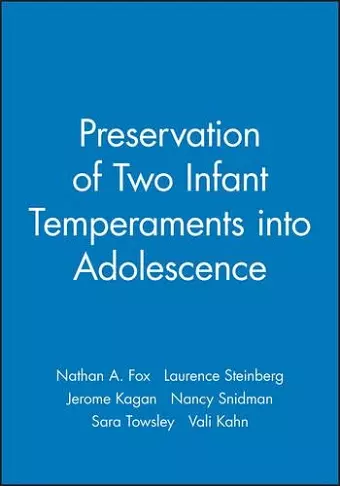Preservation of Two Infant Temperaments into Adolescence
Jerome Kagan author Laurence Steinberg author Nathan A Fox author Nancy Snidman author Sara Towsley author Vali Kahn author
Format:Paperback
Publisher:John Wiley and Sons Ltd
Published:30th Oct '07
Currently unavailable, and unfortunately no date known when it will be back

Temperament has been a central element of the on-going effort to describe the distinctiveness of persons at every stage of development. Many researchers have examined the relations of temperament to emotions, behavior, and adjustment generally. Fewer studies have focused primarily on the nature and structure of temperament, however, and even fewer have examined the developmental course of temperament. This Monograph reports a significant exception. The authors undertook theoretically relevant behavioral, biological, and self-report assessments of a sample of 14-to-17 year olds who had been classified into one of four temperamental groups at 4 months of age. Infant temperamental categories were based on observed behavior to a battery of unfamiliar stimuli. The infants classified as high reactive (20 percent of the sample) displayed vigorous motor activity and frequent crying. Those classified as low reactive (40 percent) displayed minimal motor activity and crying. About 25 percent of the infants, called distressed, showed minimal motor activity but cried frequently, and 10 percent, characterized by vigorous motoricity but little crying, were called aroused.
Previous evaluations of these children at 14 and 21 months, and 4, 7, and 11 years had revealed that those children initially classified as high reactive were most likely to be avoidant of unfamiliar events at the early ages and emotionally subdued, cautious, and wary of new situations at the later ages. By contrast, initially low-reactive children had been the least avoidant of unfamiliarity in the second year and most emotionally spontaneous and sociable at the later ages. At age 11 years, assessments also had revealed that initially high-reactive children were more likely than the low-reactive participants to display right hemisphere activation in the EEG, a larger evoked potential from the inferior colliculus, larger event related waveforms to discrepant scenes, and greater sympathetic tone in the cardiovascular system. In the follow-up of these individuals reported here, adolescents (14-17 years of age) who had been classified as high reactive in infancy were more likely than initially low reactive participants to display sympathetic tone in the cardiovascular system, to combine a fast latency with a large magnitude of the evoked potential from the inferior colliculus, and to show shallower habituation of the event-related potential to discrepant visual events.
Moreover, compared to their low-reactive agemates, initially high reactive adolescents...
ISBN: 9781405180115
Dimensions: 231mm x 154mm x 6mm
Weight: 163g
132 pages